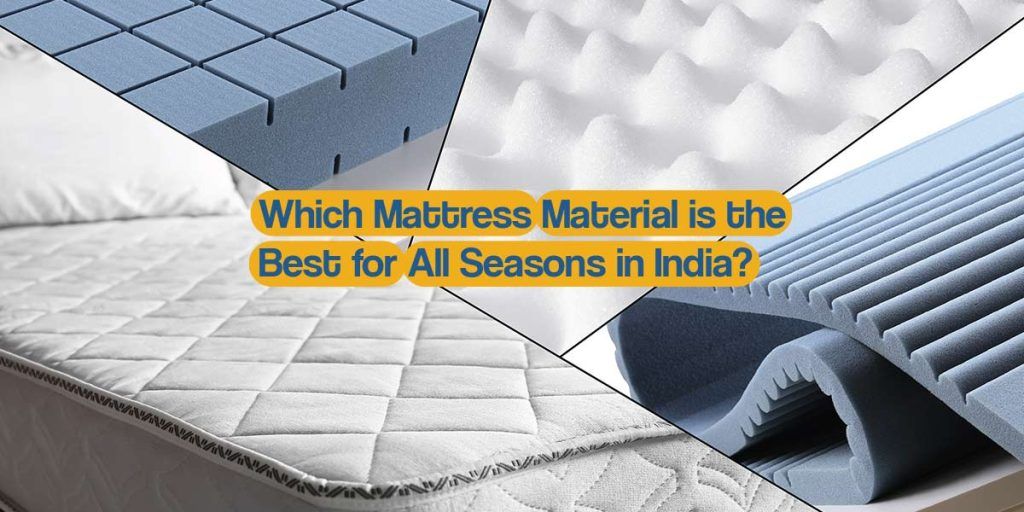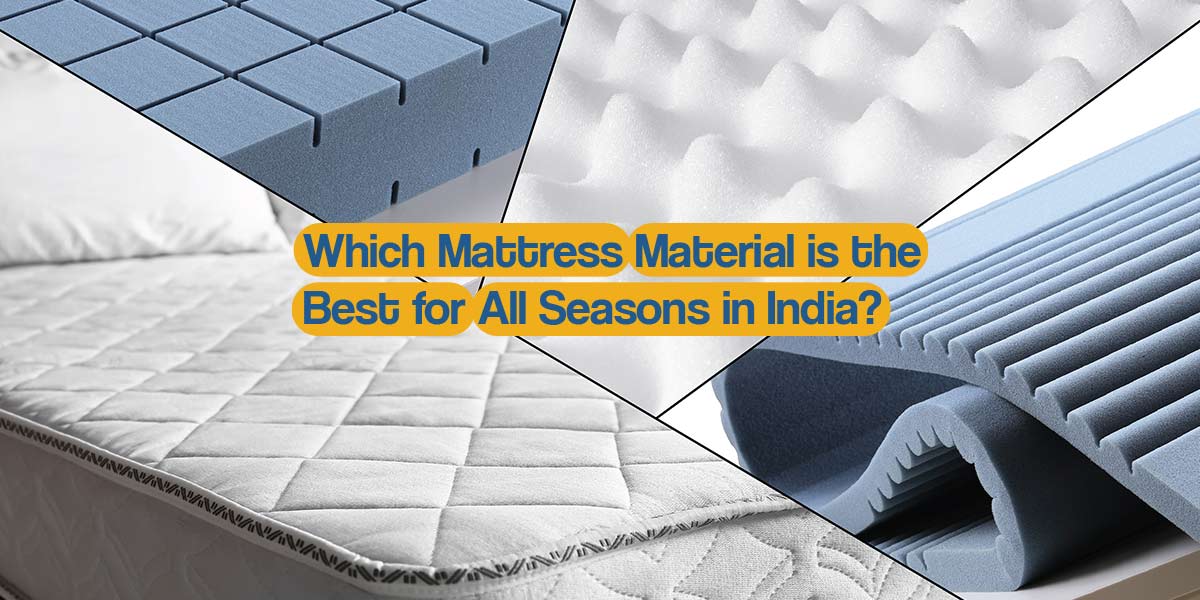
Introduction
Imagine that you have been working and are tired but still want to continue working when you have some spare time. But instead of fully recovering and feeling refreshed and energetic, you lie all night on a bad mattress.
What about the next day? Yes, you know the feeling of waking up even more exhausted than the previous day? People often find themselves uncomfortable with unsuitable mattresses, which disturb their regular sleep patterns and cause a generally unhealthy body condition.
Now, let us tell you specifically how the search for suitable mattress materials that are comfortable during both hot and cold months will positively impact your sleep quality.
Exploring Common Mattress Materials & their Features
Latex mattress
In contrast to wool, natural latex does not represent a heat accumulation but rather a heat-buffering material. Its round-shaped celled structure makes it a highly breathable fabric that helps one avoid heat buildup during the warm summer months, which is characteristic of India. Moreover, the latex mattress material also provides an adequate pressure-free implementing surface. It forms the user’s body contour, which is advantageous to the spine and joint system of the user.
- It is worth making another pit stop and pointing out that, although the two types do not contain any mattress material that change the temperature, natural latex is somewhat cooler to sleep on because it is more breathable.
- Ensure that the upper layers of seating comfort provide as much breathability as possible.
Foam mattress
It is affordable with some conditions. A solution that comes with some conditions cannot be dismissed as unattractive, although certain conditions may naturally be deemed unpalatable.
Foam mattresses encompass a wide range, including memory foam and polyurethane (PU) foam:
Memory Foam: Memory foam’s benefits include pressure relief and body, but it can absorb heat and is unsuitable for hot regions.
PU Foam: Plush/PU foam has a firmer look and feel than memory foam and is more breathable – so it is ideal for hot and humid weather.
Considerations for Foam Mattresses:
- Memory foam, for instance, has limitations that make it appropriate for cooler climates, while PU foam has better capacity in the same ventilation area.
- It provides good support: memory foam visco-elastically adapts to the body’s contours, and PU foam is known to be more ‘springy.’
Spring mattress
Spring mattresses utilise metal coils for support and softer comfort layers.
Temperature Regulation: Coiling spring mattresses has always been advantageous, allowing for proper airflow, especially in spring. However, it is better to choose open-coil ones due to their superior breathability in contrast with pocketed coils.
Support & Comfort: When choosing Spring mattresses, one should consider various perks such as a good level of support and a good bounce. They appeal to clients who wish to have more pronounced contouring of the body and clients who sleep supine.
Considerations for Spring Mattresses:
- Spring mattresses that are responsive to motion mostly use Bonnell coils.
- A conventional spring mattress may deteriorate and fail to provide proper support for the spine after some time, irrespective of the mattress material quality of the coils used.
Coir mattress
Made from coconut coir fibers, coir mattresses offer a unique sleeping experience.
Temperature Regulation: Coir fibre, being fully biodegradable, is more suitable for hot/tropical climate zones as it Retains moisture; it is Breathable and does not hold water or moisture.
Support: Coir is firm, making it suitable for proper back support.
Considerations for Coir Mattresses:
- Coir can be rather stiff, which may not be very comfortable for most people. This is especially so for those who prefer side sleeping since they need more pressure relief.
- Coir mattresses usually have a certain degree of softness that they might retain in case they are not put on the proper base.
Hybrid mattress
Hybrid mattresses combine mattress materials like latex, memory foam, springs, and coir. This provides flexibility since one can now gauge which mattress material is suitable for the type of customisation. When considering the bedding, consider a hybrid bedding that has breathable top layers such as latex or gel-infused foam during the hot summer and a memory foam layer that is slightly warm for colder environments like the winter.
Factors to Consider When Choosing a Mattress for Different Seasons
Here’s how climate can impact your mattress choice:
Hot and Humid Climates: There is a special category of mattresses, such as natural latex or innerspring mattresses with an open coil structure. These mattress materials encourage air permeability, which helps avoid heat-trapping and is best used when one wants to sleep cooler at night.
Temperate Climates: Although older products such as latex and innerspring mattresses remain popular, they are also favourable because they can breathe. Memory foam can also work, but the best option is if the salesman also prescribes a lower-density foam or a breathable top layer.
Cold Climates: It should be noted, however, that some measure of heat retention is not necessarily evil, especially regarding the Sarma. As you’ll find with our series, memory foam mattresses, particularly those with higher-density foam, can do this to some extent.
Conclusion
Selecting the correct and suitable mattress material type for the prevailing climate is essential to achieving the correct sleeping environment for adequate rest and recovery all year round. As said above, it is important to stress that a good night’s sleep is an excellent investment in every person’s health.
Centuary Mattress is the best mattress for all climates, providing sleep and comfort. Choose Centuary Mattress and wake up refreshed and ready to take on the day!
FAQs
Q1: Are there specific mattress materials to avoid for hot summers in India?
Choosing the type of mattress to use is usually an individual decision. However, some mattress materials used in producing mattresses are known to retain heat, and those who experience hot flushes at night are likely to consider using such mattresses a nightmare.
Q2: Can mattress material affect sleep quality during the summer season?
One should learn that the type of mattress material can influence sleep quality when the climate is warm. Choose natural latex, a popular material for mattress making, or innerspring mattresses with open coils.
Q3: Do certain mattress materials have better moisture-wicking properties for Indian seasons?
Latex mattresses are characterised by natural latex and innerspring with open coil designs. The structures also possess an open cell configuration, enabling the air to flow over them so as not to cause sweat buildup.
Q4: How do I determine the best mattress material for my specific needs and preferences in India?
Knowing which mattress material is the best among the types sold in India is essential for comfort, support, climate, and durability.
- A memory foam mattress best serves back pain as it has excellent support
- Latex variety is environmentally friendly and perfect for hot climates.
- Spring mattresses are an excellent choice as they offer good support and allow air to pass through them.

